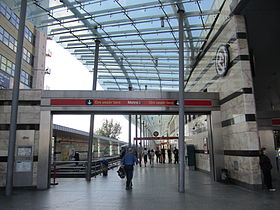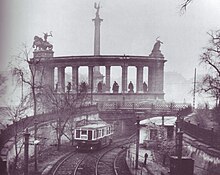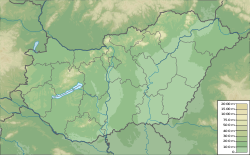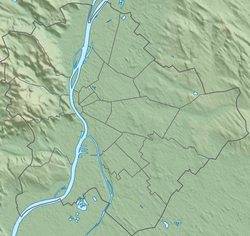Budapest Metro
show This article may be expanded with text translated from the corresponding article in Hungarian. (October 2016) Click [show] for important translation instructions. |
This article needs additional citations for verification. (January 2016) |
 | ||
 | ||
 Top: Örs vezér tere terminus of Red Line 2 Bottom: Green Line 4, a driverless metro line with real-time PIDS system at Kálvin tér, a transfer station to Blue Line 3 | ||
| Overview | ||
|---|---|---|
| Native name | Budapesti metró | |
| Owner | Capital City of Budapest | |
| Locale | Budapest, Hungary | |
| Transit type | Rapid transit | |
| Number of lines | 4 | |
| Number of stations | 48 | |
| Daily ridership | 1.27 million (2009)[1] | |
| Annual ridership | 232.8 million (2020)[2] | |
| Website | BKK Public Transport | |
| Operation | ||
| Began operation | 2 May 1896 | |
| Operator(s) | Centre for Budapest Transport Budapest Transport Ltd. (BKV) | |
| Technical | ||
| System length | 39.7 km (24.7 mi) | |
| Track gauge | 1,435 mm (4 ft 8+1⁄2 in) (standard gauge) | |
| Top speed | 80 km/h (50 mph)[3] | |
| ||
The Budapest Metro (Hungarian: Budapesti metró) is the rapid transit system in the Hungarian capital Budapest. It is the oldest underground railway system in continental Europe, and is only pre-dated by the London Underground.[4] Budapest's iconic Line 1 was completed in 1896.[5][6]
The M1 line became an IEEE Milestone due to the radically new innovations in its era: "Among the railway’s innovative elements were bidirectional tram cars; electric lighting in the subway stations and tram cars; and an overhead wire structure instead of a third-rail system for power."[7] Since 2002, the M1 line was listed as a UNESCO World Heritage Site.[8]
History[]



| UNESCO World Heritage Site | |
|---|---|
 Siemens-Halske, Budapest metro museum | |
| Official name | Andrássy Avenue and the Underground |
| Location | Budapest, Hungary |
| Part of | Budapest, including the Banks of the Danube, the Buda Castle Quarter and Andrássy Avenue |
| Criteria | Cultural: (ii), (iv) |
| Reference | 400bis-002 |
| Inscription | 1987 (11th Session) |
| Extensions | 2002 |
| Area | 57.85 ha (0.2234 sq mi) |
| Buffer zone | 239.61 ha (0.9251 sq mi) |
| Website | https://www.bkv.hu/ |
| Coordinates | 47°29′19″N 19°5′13″E / 47.48861°N 19.08694°E |
 Location of Budapest Metro in Hungary | |
The original metro line 1 (Földalatti) ran for 5 km from Vörösmarty tér to Széchenyi fürdő[9] (from Hungarian föld "earth, ground", alatt "under"; so "the underground"). The M1 Line was inaugurated on May 2, 1896, the year of the millennium (the thousandth anniversary of the arrival of the Magyars), by emperor Franz Joseph.[10] It was named "Franz Joseph Underground Electric Railway Company".
Work on line 2 started in the 1950s, although the first section did not open until 1970. It follows an east–west route, connecting the major Keleti (Eastern) and Déli (Southern) railway stations.[9]
Planning for Line 3 began in 1963 and construction started in 1970 with help of Soviet specialists.[citation needed] The first section, consisting of six stations, opened in 1976. It was extended to the south in 1980 with five additional stations, and to the north in 1981, 1984, and 1990, with nine additional stations. With a length of approximately 16 kilometres (9.9 mi) and a total of 20 stations, it is the longest line in Budapest.[citation needed]
In the 1980s and 1990s, Line 1 underwent major reconstruction. Of its 11 stations, eight are original and three were added during reconstruction. The original appearance of the old stations has been preserved, and each station feature displays of historical photographs and information. There is also a Millennium Underground Museum in the Deák Ferenc Square concourse.[citation needed]
Construction of the fourth Metro line began in 2004.[11]
Routes[]
The metro consists of four lines (M1–M4), each denoted by a different colour. M1 (yellow) Földalatti runs from Mexikói út south-west towards the river. The M2 (red) line travels east–west through the city, crossing the Danube. The M3 (blue) runs in a broadly north–south alignment, interchanging with the three other lines. The M4 (green) line commences at Keleti pályaudvar and travels south-west, crossing the river, to terminate at Kelenföld vasútállomás.[9]
| Line | Color | Name and Route | Year of opening | Length (km) |
Number of stations |
|---|---|---|---|---|---|
| Yellow | Line M1 (Vörösmarty tér ↔ Mexikói út)[12] |
1896 | 4.4 | 11 | |
| Red | Line 2 (Déli pályaudvar ↔ Örs vezér tere)[13] |
1970 | 10.3 | 11 | |
| Blue | Line 3 (Újpest-Központ ↔ Kőbánya-Kispest)[14] |
1976 | 17.3 | 20 | |
| Green | Line 4 (Keleti pályaudvar ↔ Kelenföld vasútállomás)[15] |
2014 | 7.3 | 10 | |
| Total: | 39.4 | 52 | |||
Metro line M1[]

Line 1 runs northeast from the city centre on the Pest side under Andrássy út to the Városliget, or City Park. Like Metro 3, it does not serve Buda. Line 1, the oldest of the metro lines operating in Budapest, has been in constant operation since 1896. There are plans for the future for a resurrection with more stations.[16]
Metro line M2[]
Line 2 runs east–west from Déli pályaudvar in Buda's Krisztinaváros, through the city center, to Örs vezér tere in eastern Pest. It offers connections to Hungarian State Railways at Déli and Keleti pályaudvars, to metro Lines 1 and 3 at Deák Ferenc tér, to line 4 at Keleti pályaudvar, to suburban railway lines 8 and 9 at Örs vezér tere, and to suburban railway line 5 at Batthyány tér. Prior to line 4's opening, it was (for more than 45 years) the only metro line that served the Buda side of the river. Line 2 underwent major reconstruction in the late oughts, with all of the track and stations completed in 2008.[citation needed]
Metro line M3[]

Line 3 runs in a north–south direction (more exactly, from north-northeast to southeast) on the Pest side of the river and connects several populous residential areas with the Inner City.[17] It has a transfer station with Line 1 and Line 2 at Deák Ferenc tér, and a transfer station for Line 4 at Kálvin tér. It is the longest line in the Budapest Metro, its daily ridership is estimated at 610,000.[18] Metro line 3 had not been renovated since its inauguration in 1976, although an automatic train drive system was introduced in 1990.[19] Between 2017 and 2022, the planned upgrades will include renewing the stations, rebuilding the track, safety equipment, ventilation and tunnel insulation. The design works are entirely funded by the European Union under the New Széchenyi Plan. The project also includes a possible extension of the metro line to Káposztásmegyer.[20]
Metro line M4[]

Line 4 runs southwest–northeast from Kelenföldi pályaudvar in Buda's Kelenföld neighborhood to Keleti Railway Station in Józsefváros. With a length of 7.4 kilometres (4.6 mi), it connects to Hungarian State Railways at its termini, to the metro's Line 3 at Kálvin tér, and to Line 2 at Keleti. Line 4 was completed in March 2014 and comprises ten stations.[21]
Future expansion[]
Metro line M5[]

The Purple Line 5 is a proposed north–south railway tunnel to connect the currently separated elements of the suburban rail network, namely the , and H7 HÉV-lines, and optionally the Budapest-Esztergom and Budapest-Kunszentmiklós-Tass railway lines. Currently the project does not have mainstream political support, only included in long-term plans. The first phase (planned until 2030)[22] would be the extension and connection of the southern H6 and H7 lines to the Astoria metro station via the Kálvin tér, thus connecting these lines to the metro lines M2 M3 and M4. The second phase would create a connection to the metro line M1 as well at the Oktogon, the M3 at Lehel tér then cross the Danube to the Buda side to connect the H5 HÉV towards Szentendre.[citation needed]
General information[]
Tickets and transfer system[]
The usual BKK tickets and passes can be used on all lines. Single tickets can be re-used when changing metro lines.[23]
There are plans for an automated fare collection system.[24] A contract for a system was signed in 2014,[25] but terminated in 2018 without completion.[26]
In popular culture[]
The internationally acclaimed 2003 Hungarian thriller Kontroll is set and was filmed in the metro system.
A scene in John Huston's 1981 film Escape to Victory features the historic Metro Line 1 as the Paris Métro in the 1940s.
A long fight sequence in the 2003 action film Underworld was filmed in the Budapest Metro.
Nyugati pályaudvar metro station also appears in the 2021 Marvel Cinematic Universe film Black Widow.
Network Map[]
See also[]
- List of metro systems
- List of automated urban metro subway systems
Notes[]
References[]
- ^ Mátyás Jangel (September 2010). "Közszolgáltatási szerződés, utasjogok, a szolgáltatástervezés és ellenőrzés folyamata a kötöttpályás helyi- és elővárosi közforgalmú közlekedésben" [Public service contract, passenger rights, service planning and monitoring process of local and suburban public transport rail] (in Hungarian). BKV Zrt. Közlekedési Igazgatóság [Directorate of Public Office. Transport]. pp. 10 (and 3). Archived from the original (pdf) on 2015-01-28. Retrieved 2015-04-19. Metro usage per day – Line 1: 120,000; Line 2: 405,000; Line 3: 630,000. (Line 4 began operations in 2014, with a 110,000 ridership estimated by Centre for Budapest Transport (BKK) based on the latest year.)
- ^ "Urban passenger traffic in Hungary and Budapest by mode of transport". Hungarian Central Statistical Office. 2021-08-18. Retrieved 2021-09-14 – via STADAT.
- ^ Siemens.com Budapest Line 4
- ^ Jennifer Walker (19 December 2018). "Budapest M1: Inside continental Europe's oldest metro network". CNN. Retrieved 29 July 2019.
- ^ "World Heritage Committee Inscribes 9 New Sites on the World Heritage List". UNESCO World Heritage Centre. Archived from the original on November 28, 2009.
- ^ "Our thematic route with... - Sightseeing along the line of Millennium Underground Railway". BKV Zrt. Retrieved 2013-10-18.
- ^ Budapest’s Electric Underground Railway Is Still Running After More Than 120 Years [1]
- ^ UNESCO World Heritage Centre. "UNESCO World Heritage Centre – World Heritage Committee Inscribes 9 New Sites on the World Heritage List". whc.unesco.org. Archived from the original on 28 November 2009. Retrieved 10 April 2013.
- ^ Jump up to: a b c Robert Schwandl. "Budapest". UrbanRail.net. Retrieved 1 August 2019.
- ^ https://dailynewshungary.com/first-underground-railway-europe-even-franz-joseph-used/
- ^ https://www.intelligenttransport.com/transport-articles/9633/budapests-new-bus-service-framework/
- ^ Robert Schwandl. "Line M1 Vörösmarty tér - Mexikói út". UrbanRail. Retrieved 27 March 2019.
- ^ Robert Schwandl. "Line M2 Déli pályaudvar - Örs vezér tere". UrbanRail. Retrieved 27 March 2019.
- ^ Robert Schwandl. "Line M3 Újpest-Központ - Kõbánya-Kispest". UrbanRail. Retrieved 29 July 2019.
- ^ Robert Schwandl. "Line M4 Keleti pályaudvar- Kelenföld vasútállomás". UrbanRail. Retrieved 27 March 2019.
- ^ "M1-es metró korszerűsítése és meghosszabbítása - Budapesti Közlekedési Központ". Budapesti Közlekedési Központ (in Hungarian). Retrieved 2017-10-01.
- ^ Budapest City Atlas, Dimap-Szarvas, Budapest, 2011, ISBN 978-963-03-9124-5
- ^ Metro4 - How does it work?
- ^ https://www.railjournal.com/passenger/metros/budapest-metro-line-3-reconstruction-enters-final-phase/
- ^ "Megjelent az M3-as metróvonal rekonstrukciójának tervezésére kiírt pályázat". Budapesti Közlekedési Központ. 25 July 2013. Retrieved 1 June 2021.
- ^ "Automated metro Line M4 opens in Budapest". Railway Gazette. 28 March 2014. Retrieved 9 April 2015.
- ^ Balázs Mór plan, long term service development plans of the BKK
- ^ "Types and prices".
- ^ (in Hungarian) https://tldr.444.hu/2018/03/12/mar-milliardokert-uzemeltetjuk-budapesten-az-elektronikus-jegyrendszert-holott-meg-el-sem-keszult
- ^ "Budapest signed the Contract Agreement for the Automated Fare Collection system". BKK Zrt. 8 October 2014. Retrieved 24 October 2014.
- ^ (in Hungarian) https://azonnali.hu/cikk/20181129_elektronikus-jegyrendszer-felmondta-a-bkk-a-beszallitoi-szerzodest
External links[]
| Wikimedia Commons has media related to Metro (Budapest). |
- Budapest Metro
- 1896 establishments in Hungary
- Railway lines opened in 1896
- History of Budapest
- Underground rapid transit in Hungary
- Railway lines in Hungary




